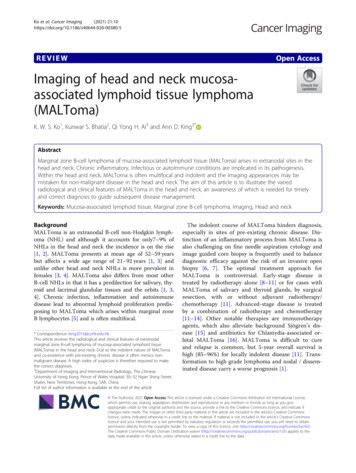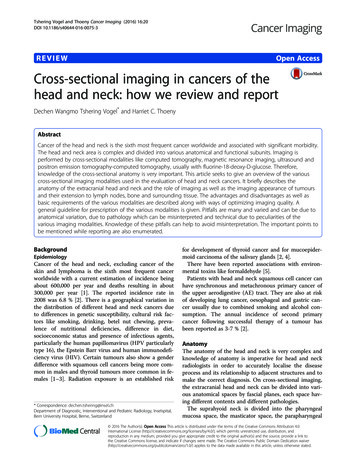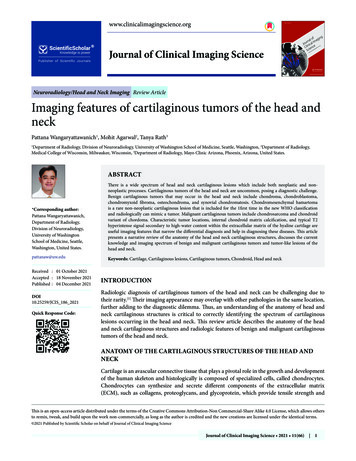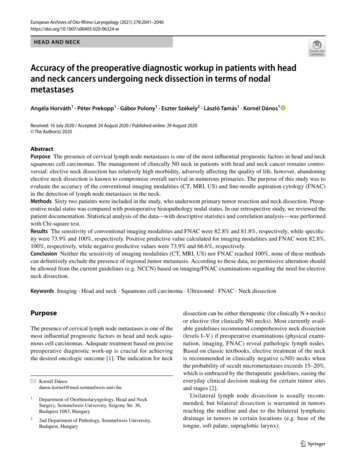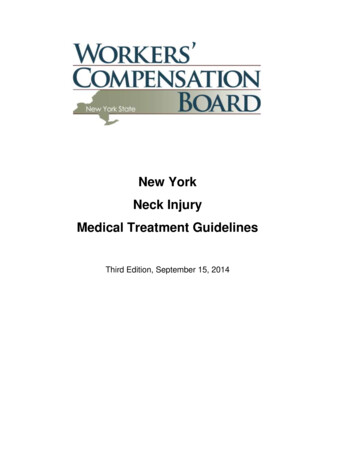
Transcription
New YorkNeck InjuryMedical Treatment GuidelinesThird Edition, September 15, 2014
New York State Workers’ Compensation BoardNew York Neck Injury Medical Treatment GuidelinesTABLE OF CONTENTSGENERAL GUIDELINE PRINCIPLES. 1MEDICAL CARE . 1RENDERING OF MEDICAL SERVICES . 1POSITIVE PATIENT RESPONSE . 1RE-EVALUATE TREATMENT. 1EDUCATION . 2DIAGNOSTIC TIME FRAMES. 2TREATMENT TIME FRAMES . 2DELAYED RECOVERY . 2ACTIVE INTERVENTIONS . 3ACTIVE THERAPEUTIC EXERCISE PROGRAM . 3DIAGNOSTIC IMAGING AND TESTING PROCEDURES . 3SURGICAL INTERVENTIONS . 4PRE-AUTHORIZATION . 4PERSONALITY/PSYCHOLOGICAL/PSYCHOSOCIAL EVALUATIONS . 4PERSONALITY/PSYCHOLOGICAL/PSYCHOSOCIAL INTERVENTION . 5FUNCTIONAL CAPACITY EVALUATION (FCE) . 5RETURN TO WORK . 6JOB SITE EVALUATION . 6GUIDELINE RECOMMENDATIONS AND MEDICAL EVIDENCE . 7EXPERIMENTAL/INVESTIGATIONAL TREATMENT . 7INJURED WORKERS AS PATIENTS . 7SCOPE OF PRACTICE . 7INTRODUCTION . 8HISTORY TAKING AND PHYSICAL EXAMINATION . 8History of Present Injury . 8Past History . 9Physical Examination . 9Relationship to Work . 10Third Edition, September 15, 2014i
New York State Workers’ Compensation BoardNew York Neck Injury Medical Treatment GuidelinesSpinal Cord Evaluation . 10Soft Tissue Injury Evaluation . 12Red Flags . 13IMAGING . 13LABORATORY TESTS . 14FOLLOW-UP DIAGNOSTIC IMAGING AND TESTING PROCEDURES . 14DIAGNOSTIC STUDIES . 16IMAGING STUDIES . 16Magnetic Resonance Imaging (MRI) . 16Computed Axial Tomography (CT) .17Myelography .17CT Myelogram . 18Lineal Tomography . 18Bone Scan (Radioisotope Bone Scanning) . 18Other Radioisotope Scanning . 18Dynamic [Digital] Fluoroscopy. 18OTHER TESTS . 19Electrodiagnostic Testing (EDX) . 19Injections – Diagnostic . 20Provocation Discography . 20Thermography . 20THERAPEUTIC PROCEDURES: NON-OPERATIVE . 20ACUPUNCTURE . 21BIOFEEDBACK . 22INJECTIONS: THERAPEUTIC . 23Therapeutic Spinal Injections-Introduction . 23Trigger Point Injections and Dry Needling Treatment . 32Prolotherapy. 34Platelet Rich Plasma (PRP). 34Epiduroscopy and Epidural Lysis of Adhesions . 34RADIOFREQUENCY ABLATION, NEUROTOMY, FACET RHIZOTOMY . 34Third Edition, September 15, 2014ii
New York State Workers’ Compensation BoardNew York Neck Injury Medical Treatment GuidelinesMEDICATION . 36Acetaminophen . 36Anti-Depressants . 37Anti-Seizure Drugs . 38Compound Medications . 39Narcotics . 39Nonsteroidal Anti-Inflammatory Drugs (NSAIDs) . 40Skeletal Muscle Relaxants . 42Systemic Glucocorticosteroids (aka “Steroids”) . 44Topical Drug Delivery . 44Tramadol . 46Vitamins . 46SPINAL CORD PROGRAMS . 46ORTHOTICS . 47Cervical Collars . 47Posture Appliances. 47Cervicothoracic Orthosis. 48Halo Devices. 48Other Orthoses, Devices and Equipment . 48RESTRICTION OF ACTIVITIES. 48RETURN TO WORK . 48Establishment of Activity Level Restrictions. 49Compliance with Activity Restrictions . 49THERAPY: ACTIVE . 49Activities of Daily Living (ADL) . 50Aquatic Therapy . 50Functional Activities . 50Functional Electrical Stimulation . 50Neuromuscular Re-education . 51Spinal Stabilization . 51Therapeutic Exercise . 51Third Edition, September 15, 2014iii
New York State Workers’ Compensation BoardNew York Neck Injury Medical Treatment GuidelinesTHERAPY: PASSIVE . 52Electrical Nerve Block . 52Electrical Stimulation (Physician or Therapist Applied) . 53Iontophoresis . 53Manipulation . 53Manipulation of the Spine under General Anesthesia (MUA) . 54Manipulation under Joint Anesthesia (MUJA) . 54Massage (Manual or Mechanical) . 54Mobilization (Joint) . 55Mobilization (Soft Tissue). 56Short-Wave Diathermy . 56Superficial Heat and Cold Therapy (Excluding Infrared Therapy) . 57Traction . 57Traction: Mechanical . 57Transcutaneous Neurostimulator (TCNS/ Electroanalgesic Nerve Block) . 58Transcutaneous Electrical Nerve Stimulation (TENS) . 58Ultrasound (Including Phonophoresis) . 58THERAPY: ONGOING MAINTENANCE CARE . 59THERAPEUTIC PROCEDURES: OPERATIVE . 60ACUTE FRACTURES AND DISLOCATIONS . 61Halo Immobilization . 61Anterior or Posterior Decompression with Fusion . 61DISC HERNIATION AND OTHER CERVICAL CONDITIONS . 63Specific Indications . 64Surgical Procedures . 65ELECTRICAL BONE GROWTH STIMULATORS . 69ARTIFICIAL CERVICAL DISC REPLACEMENT . 70PERCUTANEOUS RADIOFREQUENCY DISC DECOMPRESSION . 72EPIDUROSCOPY AND EPIDURAL LYSIS OF ADHESIONS . 72INTRAOPERATIVE MONITORING . 72IMPLANTABLE SPINAL CORD STIMULATORS (SCS) . 72Third Edition, September 15, 2014iv
New York State Workers’ Compensation BoardNew York Neck Injury Medical Treatment GuidelinesThird Edition, September 15, 2014v
New York State Workers’ Compensation BoardNew York Neck Injury Medical Treatment GuidelinesGENERAL GUIDELINE PRINCIPLESThe principles summarized in this section are key to the intended application ofthe New York State Medical Treatment Guidelines (MTG).Medical CareMEDICAL CAREMedical care and treatment required as a result of a work-related injuryshould be focused on restoring functional ability required to meet thepatient’s daily and work activities and return to work, while striving torestore the patient’s health to its pre-injury status in so far as is feasible.RENDERING OF MEDICAL SERVICESAny medical provider rendering services to a workers compensationpatient must utilize the Treatment Guidelines as provided for with respectto all work-related injuries and/or illnesses.POSITIVE PATIENT RESPONSEPositive results are defined primarily as functional gains which can beobjectively measured. Objective functional gains include, but are notlimited to, positional tolerances, range of motion, strength, endurance,activities of daily living (ADL), cognition, psychological behavior, andefficiency/velocity measures which can be quantified. Subjective reportsof pain and function should be considered and given relative weight whenthe pain has anatomic and physiologic correlation.RE-EVALUATE TREATMENTIf a given treatment or modality is not producing positive results, theprovider should either modify or discontinue the treatment regime. Theprovider should evaluate the efficacy of the treatment or modality 2 to 3weeks after the initial visit and 3 to 4 weeks thereafter. Recognizing thattreatment failure is at times attributable to an incorrect diagnosis shouldprompt the clinician to reconsider the diagnosis in the event of anunexpected poor response to an otherwise rational intervention.Third Edition, September 15, 20141
New York State Workers’ Compensation BoardNew York Neck Injury Medical Treatment GuidelinesEducationEDUCATIONEducation of the patient and family, as well as the employer, insurer,policy makers and the community should be a primary emphasis in thetreatment of work-related injury or illness. Practitioners should developand implement effective educational strategies and skills. An educationbased paradigm should always start with communication providingreassuring information to the patient. No treatment plan is completewithout addressing issues of individual and/or group patient education asa means of facilitating self-management of symptoms and prevention offuture injury.Time FramesDIAGNOSTIC TIME FRAMESDiagnostic time frames for conducting diagnostic testing commence on thedate of injury. Clinical judgment may substantiate the need to accelerateor decelerate the time frames discussed in this document.TREATMENT TIME FRAMESTreatment time frames for specific interventions commence oncetreatments have been initiated, not on the date of injury. Obviously,duration may be impacted by disease process and severity, patientcompliance, as well as availability of services. Clinical judgment maysubstantiate the need to accelerate or decelerate the time frames discussedin this document.DELAYED RECOVERYFor those patients who are failing to make expected progress 6-12 weeksafter an injury, reexamination in order to confirm the accuracy of thediagnosis and re-evaluation of the treatment program should beperformed. Assessment for potential barriers to recovery (yellowflags/psychological issues) should be ongoing throughout the care of thepatient. However, at 6-12 weeks, alternate treatment programs, includingformal psychological or psychosocial evaluation, should be considered.Referrals to mental health providers (i.e.: psychology/psychiatry) for theevaluation and management of delayed recovery do not indicate or requirethe establishment of a psychiatric or psychological condition. Theevaluation and management of delayed recovery does not require theestablishment of a psychiatric or psychological claim.Third Edition, September 15, 20142
New York State Workers’ Compensation BoardNew York Neck Injury Medical Treatment GuidelinesTreatment ApproachesACTIVE INTERVENTIONSActive interventions emphasizing patient responsibility, such astherapeutic exercise and/or functional treatment, are generallyemphasized over passive modalities, especially as treatment progresses.Generally, passive and palliative interventions are viewed as a means tofacilitate progress in an active rehabilitation program with concomitantattainment of objective functional gains.ACTIVE THERAPEUTIC EXERCISE PROGRAMActive therapeutic exercise program goals should incorporate patientstrength, endurance, flexibility, range of motion, sensory integration,coordination, and education as clinically indicated. This includesfunctional application in vocational or community settings.DIAGNOSTIC IMAGING AND TESTING PROCEDURESClinical information obtained by history taking and physical examinationshould be the basis for selection and interpretation of imaging procedureresults. All diagnostic procedures have variable specificity and sensitivityfor various diagnoses.When a diagnostic procedure, in conjunction with clinical information,provides sufficient information to establish an accurate diagnosis, asecond diagnostic procedure will be redundant if it is performed only fordiagnostic purposes. At the same time, a subsequent diagnosticprocedure (that may be a repeat of the same procedure, when therehabilitation physician, radiologist or surgeon documents the study wasof inadequate quality to make a diagnosis) can be a complementarydiagnostic procedure if the first or preceding procedures, in conjunctionwith clinical information, cannot provide an accurate diagnosis, and ispermissible under the MTG.It is recognized that repeat imaging studies and other tests may bewarranted by the clinical course and to follow the progress of treatment insome cases. It may be of value to repeat diagnostic procedures (e.g.imaging studies) during the course of care to reassess or stage thepathology when there is progression of symptoms or findings, prior tosurgical interventions and therapeutic injections when warranted, andpost-operatively to follow the healing process. Regarding CTexaminations, it must be recognized that repeat procedures result in anincrease in cumulative radiation dose and associated risks.Third Edition, September 15, 20143
New York State Workers’ Compensation BoardNew York Neck Injury Medical Treatment GuidelinesSURGICAL INTERVENTIONSContemplation of surgery should be within the context of expectedfunctional outcome. The concept of "cure" with respect to surgicaltreatment by itself is generally a misnomer. All operative interventionsmust be based upon positive correlation of clinical findings, clinical courseand imaging and other diagnostic tests. A comprehensive assimilation ofthese factors must lead to a specific diagnosis with positive identificationof pathologic condition(s). For surgery to be performed to treat severepain, there must be clear correlation between the pain symptoms andobjective evidence of its cause. In all cases, shared decision making withthe patient is advised. The patient should be given the opportunity tounderstand the pros and cons of surgery, potential for rehabilitation as analternative where applicable, evidence-based outcomes, and specificsurgical experience.PRE-AUTHORIZATIONAll diagnostic imaging, testing procedures, non-surgical and surgicaltherapeutic procedures within the criteria of the Medical TreatmentGuidelines and based on a correct application of the Medical TreatmentGuidelines are considered authorized, with the exception of the followingprocedures: Lumbar Fusion, Artificial Disc Replacements, Vertebroplasty,Kyphoplasty, Electrical Bone Growth Stimulators, Spinal CordStimulators, Intrathecal Drug Delivery (Pain Pumps), Osteochondral Autograft,Autologous Chondrocyte Implantation, Meniscal Allograft Transplantationand Knee Arthroplasty (Total or Partial Knee Joint Replacement). Theseare not included on the list of pre-authorized procedures. Providers whowant to perform one of these procedures must request pre-authorizationfrom the carrier before performing the procedure.Second or subsequent procedures (the repeat performance of a surgicalprocedure due to failure of, or incomplete success from the same surgicalprocedure performed earlier, if the Medical Treatment Guidelines do notspecifically address multiple procedures) also require SOCIAL EVALUATIONSIn select patients, diagnostic testing procedures may be useful whenthere is a discrepancy between diagnosis, signs, symptoms, clinicalconcerns or functional recovery. Psychological testing shouldprovide differentiation between pre-existing depression versusinjury-caused depression, as well as post-traumatic stress disorder,and other psychosocial issues that may include work or non-workrelated issues when such conditions are identified in the patient.Third Edition, September 15, 20144
New York State Workers’ Compensation BoardNew York Neck Injury Medical Treatment GuidelinesFor those patients who fail to make expected progress 6-12 weeks after aninjury and whose subjective symptoms do not correlate with objectivesigns and tests, reexamination in order to confirm the accuracy of thediagnosis should be made. Formal psychological or psychosocialevaluation may be considered.A professional fluent in the primary language of the patient is stronglypreferred. When such a provider is not available, services of a professionallanguage interpreter must be provided.Frequency: One time visit for evaluation. If psychometric testing isindicated by findings in the initial evaluation, time for such testing shouldnot exceed an additional two hours of professional time.PERSONALITY/PSYCHOLOGICAL/PSYCHOSOCIAL INTERVENTIONFollowing psychosocial evaluation, when intervention is recommended,such intervention should be implemented as soon as possible. This can beused alone or in conjunction with other treatment modalities. Time to produce effect: 2 to 8 weeks. Optimum duration: 6 weeks to 3 months. Maximum duration: 3 to 6 months. Counseling is not intended todelay but to enhance functional recovery. For select patients, longersupervision may be required, and if further counseling is indicated,documentation of the nature of the psychological factors, as well asprojecting a realistic functional prognosis, should be provided by theauthorized treating practitioner every 4 to 6 weeks duringtreatment.Return to WorkFUNCTIONAL CAPACITY EVALUATION (FCE)Functional capacity evaluation is a comprehensive or more restrictedevaluation of the various aspects of function as they relate to the patient’sability to return to work. Areas such as endurance, lifting (dynamic andstatic), postural tolerance, specific range-of-motion, coordination andstrength, worker habits, employability, as well as psychosocial, cognitive,and sensory perceptual aspects of competitive employment may beevaluated. Components of this evaluation may include: (a)musculoskeletal screen; (b) cardiovascular profile/aerobic capacity; (c)coordination; (d) lift/carrying analysis; (e) job-specific activity tolerance;(f) maximum voluntary effort; (g) pain assessment/psychologicalThird Edition, September 15, 20145
New York State Workers’ Compensation BoardNew York Neck Injury Medical Treatment Guidelinesscreening; (h) non-material and material handling activities; (i) cognitive;(j) visual; and (k) sensory perceptual factors.In most cases, the question of whether a patient can return to work can beanswered without an FCE.When an FCE is being used to determine return to a specific job site, thetreating physician is responsible for understanding and considering thejob duties. FCEs cannot be used in isolation to determine workrestrictions. The authorized treating physician must interpret the FCE inlight of the individual patient's presentation and medical and personalperceptions. FCEs should not be used as the sole criteria to diagnosemalingering.An FCE may be considered at time of MMI, following reasonable priorattempts to return to full duty throughout course of treatment, when thetreating physician is unable to make a clear determination on work statuson case closure.RETURN TO WORKFor purposes of these guidelines, return to work is defined as any work orduty that the patient is able to perform safely. It may not be the patient’sregular work. Ascertaining a return to work status is part of medical care,and should be included in the treatment and rehabilitation plan. It isnormally addressed at every outpatient visit. A description of the patient’sstatus and task limitations is part of any treatment plan and shouldprovide the basis for restriction of work activities when warranted. Earlyreturn to work should be a prime goal in treating occupational injuries.The emphasis within these guidelines is to move patients along acontinuum of care and return to work, since the prognosis of returning aninjured worker to work drops progressively the longer the worker has beenout of work.JOB SITE EVALUATIONThe treating physician may communicate with the employer or theemployer’s designee, either in person or by telephone, to obtaininformation regarding the demands of the patient’s pre-injury job,including a description of the exertional demands of the job, the need forrepetitive activities, load lifting, static or awkward postures, or any otherfactors that would pose a risk of re-injury or impedance of convalescence.When returning to work at the patient’s previous job task/setting is notfeasible, given the clinically determined restrictions on the patient’sactivities, inquiry should also be made about modified duty work settings,and a similar set of questions should be posed by the physician about workactivities/demands in modified duty jobs.Third Edition, September 15, 20146
New York State Workers’ Compensation BoardNew York Neck Injury Medical Treatment GuidelinesIdeally, the physician would gain the most information from an on-siteinspection of the job settings and activities; but it is recognized that thismay not be feasible in most cases. If job videos/CDs/DVDs are availablefrom the employer, these can contribute valuable information.Frequency: 1 or 2 calls 1st call: Patient is in a functional state where the patient can performsome work. 2nd call: Patient has advanced to state where the patient is capableof enhanced functional demands in a work environment.The physician shall document the conversation.OtherGUIDELINE RECOMMENDATIONS AND MEDICAL EVIDENCEThe Workers’ Compensation Board and its Medical Advisory Committeehave not independently evaluated or vetted the scientific medical literatureused in support of the guidelines, but have relied on the methodology usedby the developers of various guidelines utilized and referenced in theseGuidelines.EXPERIMENTAL/INVESTIGATIONAL TREATMENTMedical treatment that is experimental/investigational and not approvedfor any purpose, application or indication by the FDA is not permittedunder these Guidelines.INJURED WORKERS AS PATIENTSIn these Guidelines, injured workers are referred to as patients recognizingthat in certain circumstances there is no doctor-patient relationship.SCOPE OF PRACTICEThese Guidelines do not address scope of practice or change the scope ofpractice.Third Edition, September 15, 20147
New York State Workers’ Compensation BoardNew York Neck Injury Medical Treatment GuidelinesINTRODUCTIONHISTORY TAKING AND PHYSICAL EXAMINATIONHistory taking and physical examination establish the foundation/basisfor and dictate subsequent stages of diagnostic and therapeuticprocedures. When findings of clinical evaluations and those of otherdiagnostic procedures are not consistent with each other, the objectiveclinical findings should have greater weight. The medical records shouldreasonably document the following:History of Present InjuryA detailed history, taken in temporal proximity to the time of injury,should primarily guide evaluation and treatment. The history shouldinclude:B.1.a.iMechanism of InjuryThis includes details of symptom onset and progression.The mechanism of injury should include a detaileddescription of the incident and the position of the bodybefore, during, and at the end of the incident. Inclusion ofwork body postures, frequency during the workday andlifting/push/pull requirements should be included in theabsence of a known specific incident.B.1.a.iiLocation of pain, nature of symptoms, and alleviating/exacerbating factors (e.g. sleep positions). Of particularimportance is whether raising the arm over the headalleviates radicular-type symptoms. The history shouldinclude both the primary and secondary complaints (e.g.,primary neck pain, secondary arm pain, headaches, andshoulder girdle complaints).B.1.a.iiiThe use of an accepted pain assessment tool, (e.g. theVisual Analog Scale [VAS]) is highly recommended,especially during the first two weeks following injury, toassure that all work-related symptoms, including pain, arebeing addressed.B.1.a.ivPresence and distribution of upper and/or lower extremit
New York Neck Injury Medical Treatment Guidelines Third Edition, September 15, 2014 ii Spinal Cord Evaluation . All diagnostic imaging, testing procedures, non-surgical and surgical therapeuti
